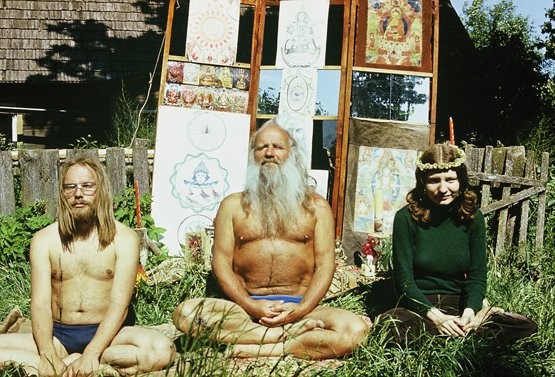Soviet Hippies: The Psychedelic Underground Of 1970s Estonia
14 Sep - 13 Oct 2013

Estonian philosopher, an expert on sanskrit, yoga and meditation, Mihkel Ram Tamm became a guru for many Soviet hippies in Estonia and from elsewhere. Aare and Julia visiting Rama in early 1970s
© From the collection of Vladimir Wiedemann
© From the collection of Vladimir Wiedemann
SOVIET HIPPIES: THE PSYCHEDELIC UNDERGROUND OF 1970S ESTONIA
14 September - 13 October 2013
Curators: KIWA & Terje Toomistu
The exhibition documents and analyzes the hippie movement in soviet Estonia – an unofficial and explosive youth culture that could unite both vagabonds and academicians.
The hippie movement, which converted hundreds of thousands of young people in the west to the cult of "peace, love and freedom" during the 1960s and 1970s, also had an impact on the other side of the Iron curtain. Coveting western freedoms and spiritually inspired by the cultures of the east, a counterculture of flower children developed in the Soviet Union, which was disengaged from the official ideology and expressed itself through rock music, love, pacifism and a physical appearance that was considered unacceptable for soviet citizens.
The hippie movement in Soviet Estonia was not a clearly defined phenomenon, but rather the distinctive flow of an explosive youth culture with a perception of life that could unite vagabonds and academicians. However, the mere trend toward hippie fashions, long hair and great rock concerts was enough to make the soviet authorities see a political threat that could subvert the regime. But the more absurd the reality, the more fanatical the soviet flower power became. They created their own world in the shadow of harsh rules and repressions, and opposed the ruling system through symbolic expression.
14 September - 13 October 2013
Curators: KIWA & Terje Toomistu
The exhibition documents and analyzes the hippie movement in soviet Estonia – an unofficial and explosive youth culture that could unite both vagabonds and academicians.
The hippie movement, which converted hundreds of thousands of young people in the west to the cult of "peace, love and freedom" during the 1960s and 1970s, also had an impact on the other side of the Iron curtain. Coveting western freedoms and spiritually inspired by the cultures of the east, a counterculture of flower children developed in the Soviet Union, which was disengaged from the official ideology and expressed itself through rock music, love, pacifism and a physical appearance that was considered unacceptable for soviet citizens.
The hippie movement in Soviet Estonia was not a clearly defined phenomenon, but rather the distinctive flow of an explosive youth culture with a perception of life that could unite vagabonds and academicians. However, the mere trend toward hippie fashions, long hair and great rock concerts was enough to make the soviet authorities see a political threat that could subvert the regime. But the more absurd the reality, the more fanatical the soviet flower power became. They created their own world in the shadow of harsh rules and repressions, and opposed the ruling system through symbolic expression.
